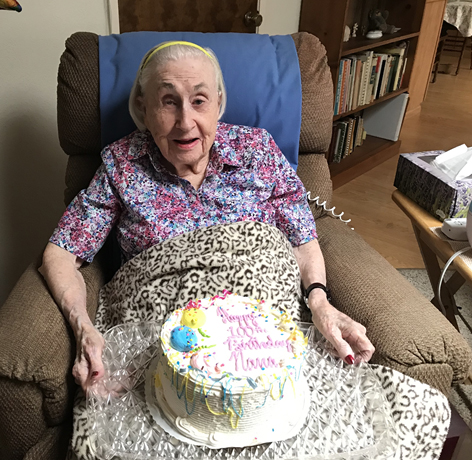When you send a bit of goodness and kindness into the world, sometimes it is returned tenfold.
Such was the case this week when the Arkansas Tech University Office of Alumni Relations received an e-mail from Danna Shirley. She had recently found an online archive of the spring 2007 edition of Tech Action magazine, and inside it was a letter that her mother, Elsie Daugherty Goines, had submitted for publication.
Goines is a member of the Tech Class of 1939, and Shirley wrote in to let Arkansas Tech know that her mother is still going strong at 100 years of age. Goines has three daughters, seven grandchildren and six great-grandchildren. She has lived in California since 1946, but has returned to the Arkansas Tech campus on several occasions over the years. Shirley said she maintains positive memories of her time at Tech more than 80 years after her graduation.
Below is the letter that Goines submitted to Tech Action in 2007. It was the result of a call for memories of Tech in advance of the ATU Centennial celebration.
I am always impressed with the improvements being made at Arkansas Tech. I graduated in 1939 when it was a junior college and known as the “Cow College.”
These were the days of the depression and FDR’s alphabet administration. I was fortunate to be able to take advantage of his N.Y.A. (National Youth Administration) program, which paid most of my room and board. I was responsible for the remainder. I believe it cost $50 cash per semester for registration.
In those days, there were two dorms: Caraway Hall for women was on one side of the campus and the men’s dorm (today known as Wilson Hall) was on the other side. Many students also lived out in town. During my first year at Tech, I took turns with several other students working for Miss Lela Jane Bryan, the dean of women at Caraway Hall. Our job consisted of answering the phone and locating the person the caller wanted. There was only one phone for the whole building, and as you know, there are three floors in Caraway Hall. Needless to say, we got our exercise for the day.
This job paid only $10 of the required $15 for my room and board, so my father paid the additional $5, which was a hardship for a farmer in Arkansas. Some of you probably cannot imagine $5 being a hardship, but remember these were depression days.
During my last year at Tech, I was able to work as a waitress in the dining hall. This was a six-and-a-half day a week job and paid for all of my room and board. Along with the waitresses, there were several fellows who bussed dishes, put them through the dishwasher and then returned them to the dining hall. The meals were family style and each waitress was responsible for four tables. We learned to carry four bowls of hot food at a time.
We were also responsible for keeping the “zip” pitchers full. Zip! What’s zip? I’m not sure why it was called zip, but it was probably Karo syrup, which the boys lavishly poured on everything from scrambled eggs to dessert, so we were constantly refilling the pitchers.
Another task was to keep the flatware polished; no stainless steel in those days. Everyone was supposed to clean their silverware at the same time, but not everyone did so. Occasionally, a tray of unpolished silverware would be returned to you instead. This caused much unhappiness to say the least.
Sunday morning we made sack lunches for the supper meal so we could have the evening off. Adelaide and Joe Sidney did all the cooking. Looking back, I can’t believe they did so. They had a young fellow we called Gabby who assisted them. I loved working in the dining hall. It was not an easy job, but we had lots of fun along with the hard work.
There was a juke box in the dining hall and periodically we had dances sponsored by Mr. Satterfield, the steward. He must have made arrangements with the record company for I don’t believe we ever put money in the juke box at all those dances.
(Female) students today who have spent most of their life in pants will be interested to know we were not allowed to wear pants (called slacks in our day) on campus. We wore dresses at mid-calf and Oxfords with bobby socks or silk hose. Nylons didn’t exist until after World War II. Tennis shoes were for gym class only.
Many of us were anxious to begin our teaching careers, and Tech offered some upper division courses so we could receive our teaching credential at the end of two years. One subject I remember well was a 10-unit course called Civilization, five units for each semester. Several of the professors lectured to approximately 100 students three days each week in the “Little Theater.”
Tuesdays and Thursdays, Mr. Delaney was responsible for discussion of the material. We also had several books and other outside reading to do. This was one of the most difficult courses of my entire college experience, chiefly because the material was so extensive.
After finishing my two years at Tech, I obtained my teaching credential and taught in Arkansas for four years. My two years at Tech were a great foundation for receiving my Bachelor of Arts degree from San Francisco State University (Calif.), where we had relocated in 1946. Unfortunately, San Francisco State did not accept my Civilization units because there was no description available to them several years later.
Thanks to Tech, I began a 30-year career in teaching. I spent most of those years at Carquinez Elementary School, which was across the way from the California and Hawaii Sugar Refinery.
I have fond memories of Arkansas Tech, and when possible, I stop by to cruise the campus. If you do the math, you’ll know those memories go back 70 years. Can my memories be exact after 70 years? Probably not, but I enjoyed getting them down on paper. Hope you enjoy them, too.
Elise Daugherty Goines, Tech Class of 1939






